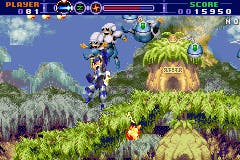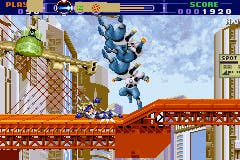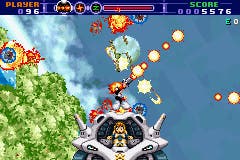Gunstar Future Heroes
Prepare the stocks. Ready the rotting fruit.
Right, well, that's it then. It's going to be one of those times where I report the facts, tell the truth, and then the entire internet will come round my house and break my kneecaps.
You might remember playing the original Gunstar Heroes on your Megadrive. And you might well be carrying a trouser-torch for it to this very day, determined that it was the greatest moment of your entire life, and that this had nothing to do with the fact that you were thirteen. And if that's you, don't bother reading. You're going to buy the GBA version anyway, and you're going to think anyone whose eyes manage to penetrate the new robe-code of this emperor is a despicable idiot. Fine, fine, I'm an idiot. Move along.
Gunstar Future Heroes is this: less than an hour long.
Can we go now?
Apparently not.
Here's the run-through: In the original Gunstar, two heroes, Red and Blue, defeated "Destructor: the God of Ruin, also know as Golden Silver," on the Moon. The Moon, as is its wont, exploded, forming four new moons, all of which now orbit the Earth. These moons were then colonised, inexplicably in meticulously arranged floating platforms, and things were just awesome. But then, shock and horror, a fifth moon appeared, the work of a mysterious organisation called The Empire. Where do they get their ideas from?

The Empire, wouldn't you know it, isn't all about being good, and they want to resurrect naughty old God of Ruin using a relic known as the Megalith. Thank goodness for 3YE, an Earth-bound organisation, and their tribute-named Gunstar Future Heroes unit.
There are, in total, six stages of the game to play through. And where Gunstar makes its most immediate and striking, and some say only, mark is in the crazed variety of these sections. You will be side-scrolling your way through infinitely spawning baddies, and then flying a rotating spaceship, before riding on what appeared to be a tipped over bin, and then you're rolling dice to move around a challenge-creating board game. Such inventive variety is immediately welcome, and a great pleasure, no matter how poorly introduced or utterly without exposition these ludicrous shifts in style may be. Trouble is, halfway through your welcoming them, they're gone. Blip, zip, over.
So, thinking there must be more - there has to be more - you play it through again using the second character. And discover it's the exact same game in every way, but for a couple of changes in the meaningless dialogue screens introducing each section, and a different coloured gun. Weeeee.
Each character has three weapons, one unique to himself, and all four are capable of a super-mega-double-extra-triple-quanto-blast type thing when the line at the top of the screen is flashing. But there's no great choice here. The unique weapon is by far the best, and the entire game can be effortlessly completed using only this. One other produces helpfully around-corner-going blasts for convenient dispatching of awkwardly placed baddies, and the third is rubbish and not worth touching.
Much has been touted of GFH's graphics, especially with people's pants exploding all over the place at E3 about it. But, unless there's something gone horribly wrong with my eyes, this is so much hyperbole and a good part complete nonsense. Conscious that I was playing the GBA cartridge on the bottom screen of my DS, I was aware I might be making the silly mistake of expecting DS standards. But then I remembered Super Monkey Ball Jr. and how utterly wonderful it looked, and how it embarrassed every other GBA developer, revealing what they should have been capable of. GFH gets nothing especially amazing out of the GBA - it looks lovely enough, and developing for the machine at this late stage, I should hope so. But it doesn't make me want to shake an SP, trying to get the benevolent demon out of it, whose possession thereof can be the only possible explanation.

So let's put a bit more effort into exploring the numerous approaches to play, as that's really what GFH offers.
Early on (which is a particularly relative term), the Cobit Village requests that you, er, save some chicks. God knows why, but that's clearly not important. The level is a large rotating disc, with platform passages in levels from the centre outward. Chicks hang about like Pac-man's dots, and invincible snake-like beasts squirm out from the walls attempting to thwart your kindly rescue. Touching a chick has it follow you, and getting touched by a snake causes all currently following chicks to abandon your safety and return to their original position. As you move, the disc rotates, keeping you at the bottom, so inventive use of bouncing off walls needs to be combined with predictions of potential gravity, all the while avoiding the slithery danger. Intriguing, huh? And indeed, as level 1 of a game based on this notion, it certainly would be. But a level 1 it is, a piece of piss to complete, and then it's gone, only continuing to exist for the numbingly pointless purpose of beating your previous best time. The level gives no sense of urgency, speed doesn't offer any imperative, use of skill doesn't cause you to accelerate. So why would you care if you did it any faster?
Then, in a second stage of a later moon, the game becomes something of a boardgame. No explanation why, no logic to this, but fine, whatever. Mad fun is why we wake up in the mornings. An oddly five-sided dice is 'rolled' (the images of dice faces are highlighted in turn, stopped by your pressing a button), and you move forward (or backward) that number of spaces. Landing on a new space opens up a mini stage, generally featuring some sort of boss. Complete it, and you can roll again. Fail, and you'll drop back a few spaces. But, and here's the big problem, there's no punishment for that. Re-landing on a space doesn't re-open the challenge. It merely asks you to roll again. And the game's so damned short that you'll deliberately aim to land on every space anyway, aided in this goal by the backward steps.
There's a section in top-down view over a city, dropping bombs on anything that moves. There's a few standing on top of a spacecraft, rotating about to shoot at the almost-3D flying enemies. And there's one peculiarly Asteroids-like section flying a very poorly controlled craft and shooting at literally everything you can find to shoot at. They're all... fine. But they were all fine as the single level in the vast, elaborate games of the 1980s they're all immediately lifted from.
There are three difficulty modes, and it could be argued that here replayability kicks in. Easy is very much so. Normal makes things a fair bit harder, but Hard presents a hefty challenge. Sadly, this challenge is generally in the form of the final boss of each section, and not anything on the route there. In fact, there's barely a single enemy that can't be dispatched by just holding the left shoulder fire button down until it's gone. Bosses require more scampering about, but without being set to Hard, all but the very last are easily defeated.

Another huge dent is the loss of any form of multiplayer. The decade old Megadrive game gained a great deal of its hook from wanting to co-op with your buddies. And despite GBA's perfect potential for a two-person gripping (see Wario Ware's excellent two-player-gaming-on-one-GBA-nonsense), the whole notion is completely absent.
This doesn't live up to the hugely overrated Astro Boy, from the same development team. And indeed appears to be equally overrated across the board. Apart from on this bit of it, which will undoubtedly be hanged in the Supreme Kangaroo Court of the Internet.
IT'S LESS THAN AN HOUR LONG.
It's like getting thrown out of the tapas restaurant of gaming only a quarter of the way into your meal. A tiny morsel of each nice idea only manages to whet your appetite for that experience, and then suddenly you're sat outside in an alleyway with nothing left to play.
It really doesn't matter how well it might execute one of these micro-levels - they're so brief as to have been barely worth bothering with.
It cannot be that games are reviewed based on the nostalgia they may generate inside you. Spraying through the pages of an album of photographs may flicker wonderful memories to light, but it doesn't throw you back in time and have you relive that very moment. There's approximately eight trillion games of this nature available for arcade emulation on MAME.








